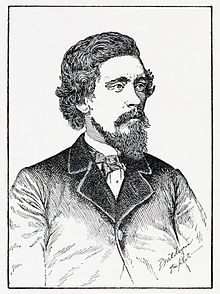Robert Kennicott
| Robert Kennicott | |
|---|---|
 |
|
| Born |
November 13, 1835 New Orleans, Louisiana, U.S. |
| Died | May 13, 1866 (aged 30) Near Fort Nulato, Russian America |
| Nationality | American |
| Fields | Zoology, herpetology |
Robert Kennicott (November 13, 1835 – May 13, 1866) was an American naturalist and herpetologist. Chronic illness kept Kennicott out of school as a child. Instead, Kennicott spent most of his time outdoors, collecting plants and animals. His father schooled him at home and convinced naturalist Jared Potter Kirtland to take him as an understudy. Soon, Kennicott was providing specimens for the Smithsonian Institution via assistant secretary Spencer Fullerton Baird.
Kennicott advocated for the study and protection of native prairie animals in an era when farmers sought to eradicate them. He teamed with Northwestern University to found a natural history museum in 1857, then founded the Chicago Academy of Sciences. While in Chicago he served as a mentor to several young naturalists, including William Healey Dall. He joined the Megatherium Club and studied specimens in Hudson Bay. The Western Union Telegraph Expedition commissioned Kennicott as a scientist for their excursion in the mid-1860s. Kennicott died on the expedition and was memorialized as the namesake of Alaska's Kennicott Glacier. His home, "The Grove" in Glenview, Illinois, is today recognized as a National Historic Landmark by the National Park Service.
Robert Kennicott was born in New Orleans, Louisiana, on November 13, 1835. His father, John Albert, was interested in botany and maintained a large land holding in Northfield Township, Cook County, Illinois, which came to be known as "The Grove". Robert was a sickly child and attempted to improve his overall health by spending lots of time outdoors. He did not attend school regularly, but his father ensured that he received an education at home. Under the tutelage of his father, Kennicott learned to patiently observe nature and began a collection of specimens.
...
Wikipedia
